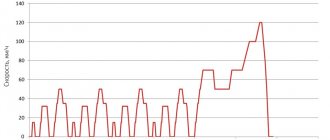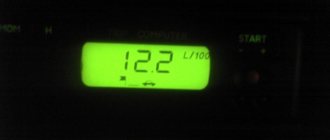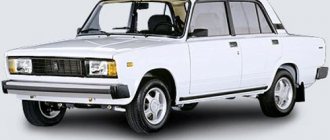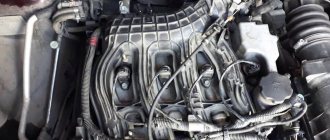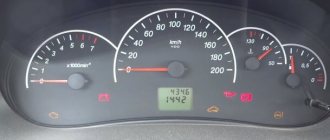Does a car heater use gasoline?
As other speakers have already correctly answered, the main interior heater of a modern car does not consume fuel. However, let's return to the design of cars and examine the answer in more detail.
To begin with, let’s ask ourselves the question – why do we need a cabin heater or “stove”. Obviously, it is necessary if the car is operated in a temperate or cool climate. Typically, heat obtained directly from the engine is used to heat the vehicle interior.
The scheme is implemented very simply: to cool the internal combustion engine (ICE), a liquid is used, which can be water or, more typical for northern countries, antifreeze - a special coolant with extremely low pour points. Engine fluid is needed to remove heat from hot parts. This occurs due to the pressure created by the pump driven from the engine. The liquid circulates in a closed system and passes through special channels inside the motor itself. Typically, the operating temperature of the engine is between 85-105 degrees Celsius. The entire cooling system is designed in such a way that the engine itself can regulate the temperature to the required values - exceeding the temperature can lead to boiling of the coolant (antifreeze or water) and engine failure due to overheating. The body responsible for regulating the temperature in the engine is the thermostat - a special valve that regulates the movement of fluid inside the cooling system. While the engine is cold, the liquid circulates in the so-called “small circle”, which, in addition to the engine itself and the cooling system hoses, also includes the heat exchanger (radiator) of the car interior - or, in other words, the “stove”. When a certain temperature value is exceeded, the thermostat opens and the liquid begins to circulate in a large circle, which also includes a large radiator located in the front of the car. It is necessary for cooling the liquid, which occurs both by the incoming air flow and by additional electric fans that are started by the car itself at the right moment.
Accordingly, in order to heat the car interior with warm air, you just need to turn on the fan installed on the cabin heat exchanger. When it is turned on, air is captured from the environment, which enters through the cabin filter directly to the hot heat exchanger, where it is directly heated and then sent to the car interior. The driver can adjust the speed of the flow created by the fan and, using a damper system, can direct the air to the desired parts of the cabin. From here we draw the main conclusion - to heat the interior of a car with an internal combustion engine, only the heat generated by the engine itself during operation is required. Thus, turning on the “stove”, implemented by turning on the blower fan, does not lead to additional fuel consumption - only electricity is consumed to operate the fan itself, which, in general, is in abundance in a modern car with an internal combustion engine. Effective ways to improve your financial situation How to make money work? How to learn to save? Is blogging a way to make money or a hobby?
see also
Comments 9
The running air conditioner can directly affect the consumption; on small cars, its clutch strains the engine very much; when overtaking, the book generally advises turning it off.
As for the stove, there is an electric motor, but it doesn’t consume much, of course there is a load on the generator, the generator loads the engine more, it is for this reason that the headlights on reduce the warm-up of the engine by as much as half.
Another point is that the stove can cool down the antifreeze, the temperature will drop and the brain will switch the engine to warm-up mode, and then the consumption can increase by 1.5-2 times. But it can be tracked. If the car has a tachometer, then we simply observe, if the car is parked in the yard, the engine starts, the heater is on. If the revolutions were idling (700-800), after turning on the heater after some time they jumped to 1000 or more, then they are warming up and guzzling gasoline.
Source
Does fuel consumption increase when the car's heater is on?
Does turning on the heater in the cabin affect gas mileage? This question can be answered this way: it increases, but only slightly. Consumption increases due to an increase in the load on the car's electrical network (on the generator). Gasoline is spent only to rotate the electric motor. The same way it is spent on turning on the low or high beam headlights or turning on the heated seats or mirrors. That is, there is an increase, but it is so insignificant that it is not even worth taking into account.
This misconception (that the heater supposedly overuses gasoline) occurs due to the fact that people start using the stove in the cold season, and when the temperature drops, fuel costs increase for completely different reasons. The increase in consumption occurs due to frequent and long warm-ups, due to the fact that in the cold season all lubricating fluids thicken and it is difficult for the engine to turn them over. A significant increase occurs due to the density of the atmosphere, since it is not gasoline or diesel fuel that burns in the engine, but a mixture consisting of small particles of fuel and air. In winter, the atmospheric density is higher and consumption increases accordingly. In this case, we can say with confidence that the turned on heater almost does not change fuel costs; external factors (ambient pressure and temperature) have a greater influence on fuel costs. This situation can be changed by leaving your car in a warm place, where the time from starting the engine to starting to move will not be as long as compared to warming up a car left outside.
How does the stove affect fuel consumption? Why does a car consume more fuel in winter?
In this article we will try to understand how fuel consumption affects the operation of a heating stove in winter.
As you know, any engine generates a lot of heat during operation, so it has a liquid cooling system, and it is from there that the furnace takes the heat, with the exception of cars that have autonomous furnaces and an engine air cooling system. On all other cars, antifreeze or antifreeze heats up and enters the radiator of the stove and the cabin becomes warm. Since the heater in the cabin has not only a radiator, but also a small electric fan that pumps out heat. As you know, any active electrical appliance to some extent affects fuel consumption, albeit not greatly.
In the summer, the stove does not work, but a much more powerful and high-speed external engine cooling fan periodically turns on in pulsating mode. Although it does not always work, but intermittently, if you compare its power and the power of the stove fan, then the overall coefficient of electricity consumption of the external fan will be much higher than that of the stove.
The main reason for excess fuel consumption in winter is that in winter the car engine takes a long time to warm up. Every cold start is associated with a lack of necessary thermal clearances. This is why when the engine is cold you have more smoke coming out of the exhaust pipe, and therefore more fuel is consumed than would be the case with a hot engine. Therefore, in winter, fuel consumption is 20-30 percent more and the stove has nothing to do with it.
I would be very grateful if you subscribe to my channel.
Source
Does fuel consumption increase when the car's heater is on?
Does turning on the heater in the cabin affect gas mileage? This question can be answered this way: it increases, but only slightly. Consumption increases due to an increase in the load on the car's electrical network (on the generator). Gasoline is spent only to rotate the electric motor. The same way it is spent on turning on the low or high beam headlights or turning on the heated seats or mirrors. That is, there is an increase, but it is so insignificant that it is not even worth taking into account.
This misconception (that the heater supposedly overuses gasoline) occurs due to the fact that people start using the stove in the cold season, and when the temperature drops, fuel costs increase for completely different reasons. The increase in consumption occurs due to frequent and long warm-ups, due to the fact that in the cold season all lubricating fluids thicken and it is difficult for the engine to turn them over. A significant increase occurs due to the density of the atmosphere, since it is not gasoline or diesel fuel that burns in the engine, but a mixture consisting of small particles of fuel and air. In winter, the atmospheric density is higher and consumption increases accordingly. In this case, we can say with confidence that the turned on heater almost does not change fuel costs; external factors (ambient pressure and temperature) have a greater influence on fuel costs. This situation can be changed by leaving your car in a warm place, where the time from starting the engine to starting to move will not be as long as compared to warming up a car left outside.
Why do you need to turn the heater on low when warming up the engine in cold weather? Auto mechanic answers
Welcome to my car channel!
Today I will tell you why, when warming up a cold engine in cold weather, the heater needs to be turned on to the very minimum, and I will also tell you about the correct method for warming up the engine (which will protect the power unit from rapid wear), which an experienced auto mechanic told me about.
Many motorists do not pay due
attention to warming up the engine, and some even do it incorrectly, which is why in some cases they end up in repairs.
In winter, many drivers, immediately after starting the engine, turn on the cabin heater to maximum in order to quickly warm up the interior and start driving, but this is not correct.
and now I’ll tell you why.
The fact is that when the stove is operating, the engine experiences increased load because it has not yet warmed up enough and has not reached the operating temperature.
When the heater is operating, the coolant cools, giving off heat to the cabin, which is why the engine takes longer to warm up, and if you start moving, the engine is even more loaded, because there is insufficient
viscosity and therefore lubricates engine parts less effectively. Also, when driving on a cold engine, fuel consumption is much higher.
Engine control unit malfunctions
If for some reason the engine control unit fails, the engine will receive a super-rich mixture, and accordingly, the fuel consumption rate will increase significantly. Such malfunctions can be identified by changes in engine behavior; already at the first symptoms of such breakdowns, the car owner should contact a service center, perform appropriate computer diagnostics of the engine, and then carry out competent repairs or even change the electronic control unit.
ECU (electronic engine control unit)
Clogged fuel filter
A common reason why a car starts to consume more gasoline is a clogged fuel filter. When it is clogged, an enriched mixture enters the engine, and accordingly, even without increasing the power of the power unit, increased fuel consumption is observed. To avoid such problems, it is necessary to regularly service the fuel system, clean the gas tank of accumulated water and contaminants, and change clogged fuel filters. Also, as part of such maintenance of the engine and vehicle, the air filter is replaced, which may cause problems in the operation of the engine.
Air flow meter
Which devices increase consumption and by how much?
Did you know that you can improve your fuel economy by as much as 2 times if you know exactly what devices are used and how much gas is consumed. Almost everything in our cars is powered by our fuel: either diesel or gasoline. After all, the same electrical appliances, in the end, are charged precisely from the generator, which also runs on gasoline. And, perhaps, knowing that certain devices consume significantly more than they are valuable to us in their working condition, we will refuse to use them in certain cases.
So, let's describe and then visually represent what and how much increases fuel consumption in our car!
Of course, the figures will be quite relative - after all, a lot depends on the ratio of the power of certain devices and units, the weight of the car as a whole, the number of such devices, and so on.
What and how much fuel consumes?
- It’s no joke, but the main spender among the “devices” for increasing fuel consumption is that same “gasket” between you know what. Yes, yes, the fuel consumption of our car most of all depends on the driver’s driving style. In general, it is the driving of the car that accounts for approximately 55-70% of all fuel consumed. It’s amazing how much is left over for non-essential needs!
- The second largest fuel hog is the air conditioner - when turned on for a full cooling cycle, it consumes a significant part of the engine power, and, therefore, increases its consumption - by an average of 7-13%. Let us here and further, for better clarity, try to imagine such a share of kilometers driven: how much more our car could travel on a full tank of gasoline if we did not use this or that unit or device. And in calculation we will take the average fuel consumption of 8 liters per 100 km (why exactly 8?) and the fuel tank volume of 50 liters. So, in the case of an air conditioner, averaging its fuel consumption to a figure of 11%, we find that on a full tank we travel 625 kilometers (50/8), and we do not reach almost 69 kilometers using the air conditioner. Just imagine this distance!
- If your car is equipped with an automatic transmission with hydraulic booster, then this is also not always a reason for joy - such comfort costs you (and us) approximately 7-9% loss of power and, accordingly, a similar increase in consumption - and this is about 56 kilometers lost for the sake of comfort .
- The next person who likes to dine on a high-octane meal is the car’s interior heater (simply put, a stove) - when turned on at full power along with the interior air blowing function, it consumes about 3-4% of the total fuel, and this is about 31 kilometers of mileage sacrificed for heat for each one consumed. full tank of gasoline.
- Next in terms of fuel gluttony are the headlights of our car, which increase fuel consumption by about 3%, which in terms of the same mileage is 19 kilometers.
- The power steering has almost the same appetite - about 2.5-3%, which is about 17 km of “under-mileage”.
- Next again are devices designed to either provide thermal comfort, or one or another function depending on the same temperature - the rear window heater and heated seats, as a rule, “eat up” about 2% of the fuel if they are constantly on. In total, we get a shortfall of 12.5 kilometers in each case.
- Windshield wipers and electrically heated rear-view mirrors have a slightly smaller appetite - about 1-1.5% for each, and this is a loss of about 7 kilometers.
- But the musical accompaniment of your trip will cost a little less - however, this is only if you are not a fan of loud music and powerful subwoofers. Music of adequate volume will consume about 0.5-1% of fuel, which is only 4.5-5 kilometers of under-mileage for each full tank of the car.
- Other electrical appliances and mechanisms generally account for the remaining share of consumption - which is about 1-4% of gasoline. These are mainly devices that do not work all the time: window regulators, chargers for accessories, a cigarette lighter, and so on.





